ITECH 1100 - Revolutionizing Surgery: The Impact of 3D Printing
VerifiedAdded on 2023/06/11
|7
|1379
|57
Report
AI Summary
This report examines the transformative impact of 3D printing on surgery, highlighting its potential to enhance efficiency, effectiveness, and personalization in medical procedures. It discusses current applications such as organ transplant modeling and jaw reconstruction, along with future implications for delicate surgeries and the integration of technology into medical education. The report also addresses ethical and regulatory considerations, including cultural beliefs and the need for international standards. Furthermore, it analyzes the disruption of traditional surgery processes, focusing on the design and transplantation of 3D-printed organs, the roles of surgeons and technology, and the affected components like design tools and patient testing. The study references various research articles to support its claims and provides a comprehensive overview of how 3D printing is revolutionizing the field of surgery.
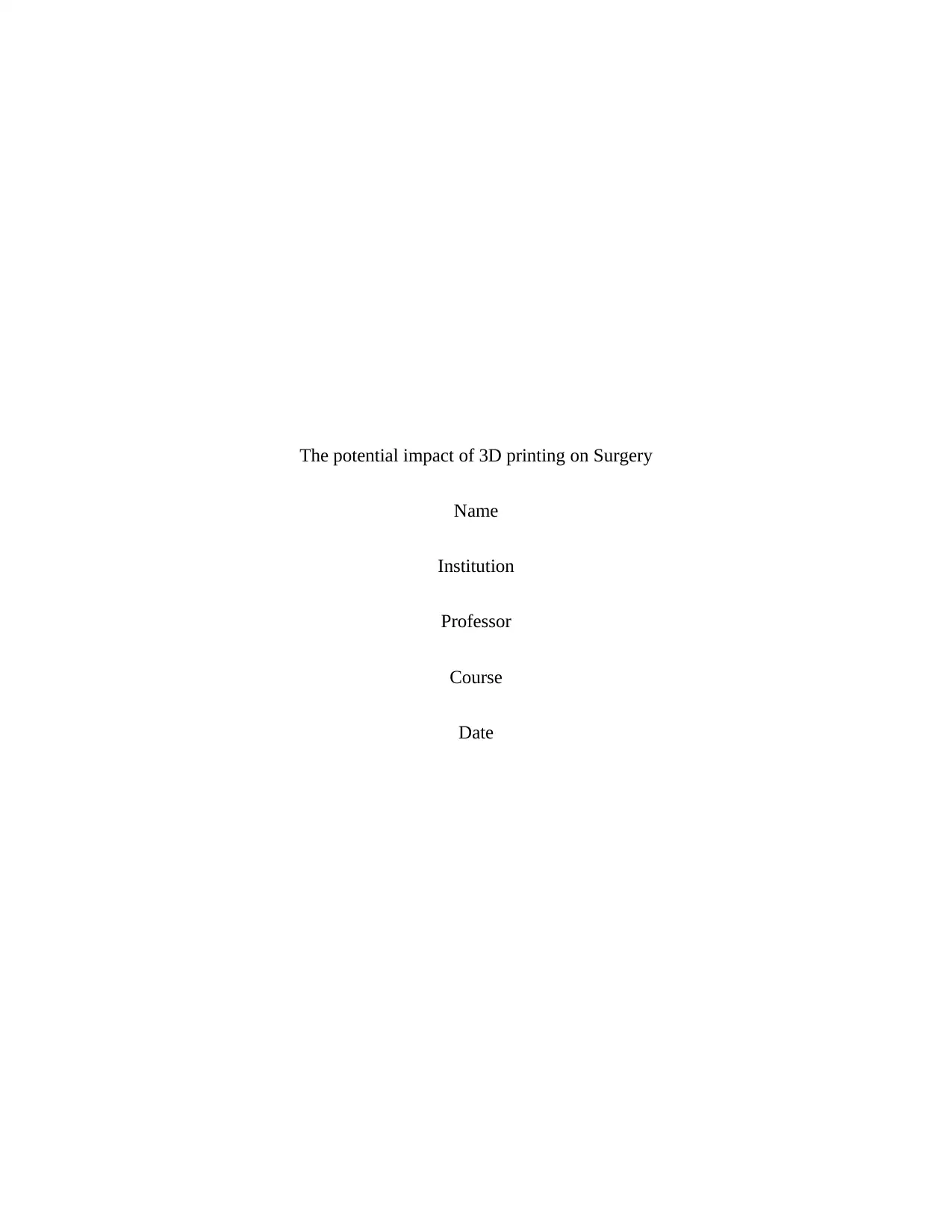
The potential impact of 3D printing on Surgery
Name
Institution
Professor
Course
Date
Name
Institution
Professor
Course
Date
Paraphrase This Document
Need a fresh take? Get an instant paraphrase of this document with our AI Paraphraser
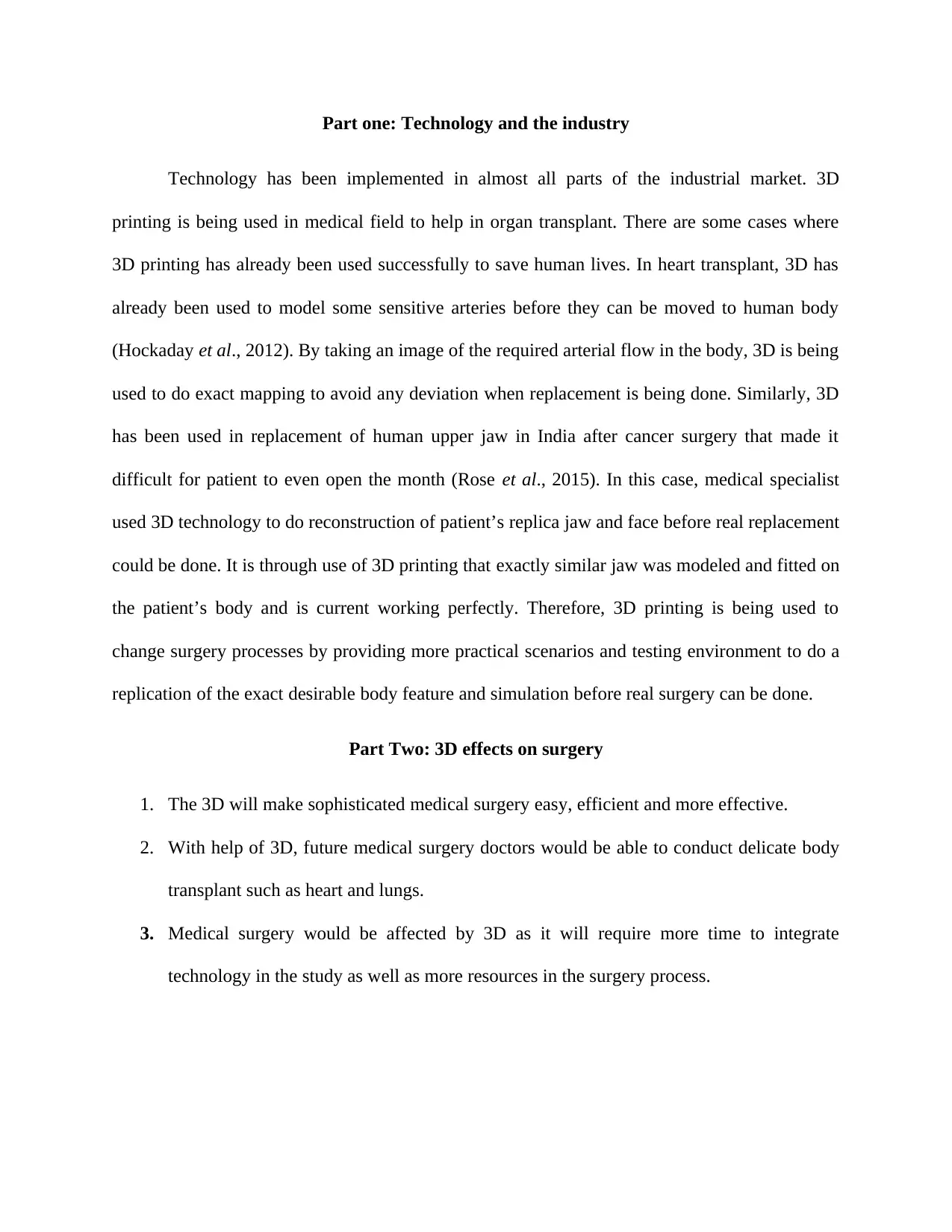
Part one: Technology and the industry
Technology has been implemented in almost all parts of the industrial market. 3D
printing is being used in medical field to help in organ transplant. There are some cases where
3D printing has already been used successfully to save human lives. In heart transplant, 3D has
already been used to model some sensitive arteries before they can be moved to human body
(Hockaday et al., 2012). By taking an image of the required arterial flow in the body, 3D is being
used to do exact mapping to avoid any deviation when replacement is being done. Similarly, 3D
has been used in replacement of human upper jaw in India after cancer surgery that made it
difficult for patient to even open the month (Rose et al., 2015). In this case, medical specialist
used 3D technology to do reconstruction of patient’s replica jaw and face before real replacement
could be done. It is through use of 3D printing that exactly similar jaw was modeled and fitted on
the patient’s body and is current working perfectly. Therefore, 3D printing is being used to
change surgery processes by providing more practical scenarios and testing environment to do a
replication of the exact desirable body feature and simulation before real surgery can be done.
Part Two: 3D effects on surgery
1. The 3D will make sophisticated medical surgery easy, efficient and more effective.
2. With help of 3D, future medical surgery doctors would be able to conduct delicate body
transplant such as heart and lungs.
3. Medical surgery would be affected by 3D as it will require more time to integrate
technology in the study as well as more resources in the surgery process.
Technology has been implemented in almost all parts of the industrial market. 3D
printing is being used in medical field to help in organ transplant. There are some cases where
3D printing has already been used successfully to save human lives. In heart transplant, 3D has
already been used to model some sensitive arteries before they can be moved to human body
(Hockaday et al., 2012). By taking an image of the required arterial flow in the body, 3D is being
used to do exact mapping to avoid any deviation when replacement is being done. Similarly, 3D
has been used in replacement of human upper jaw in India after cancer surgery that made it
difficult for patient to even open the month (Rose et al., 2015). In this case, medical specialist
used 3D technology to do reconstruction of patient’s replica jaw and face before real replacement
could be done. It is through use of 3D printing that exactly similar jaw was modeled and fitted on
the patient’s body and is current working perfectly. Therefore, 3D printing is being used to
change surgery processes by providing more practical scenarios and testing environment to do a
replication of the exact desirable body feature and simulation before real surgery can be done.
Part Two: 3D effects on surgery
1. The 3D will make sophisticated medical surgery easy, efficient and more effective.
2. With help of 3D, future medical surgery doctors would be able to conduct delicate body
transplant such as heart and lungs.
3. Medical surgery would be affected by 3D as it will require more time to integrate
technology in the study as well as more resources in the surgery process.
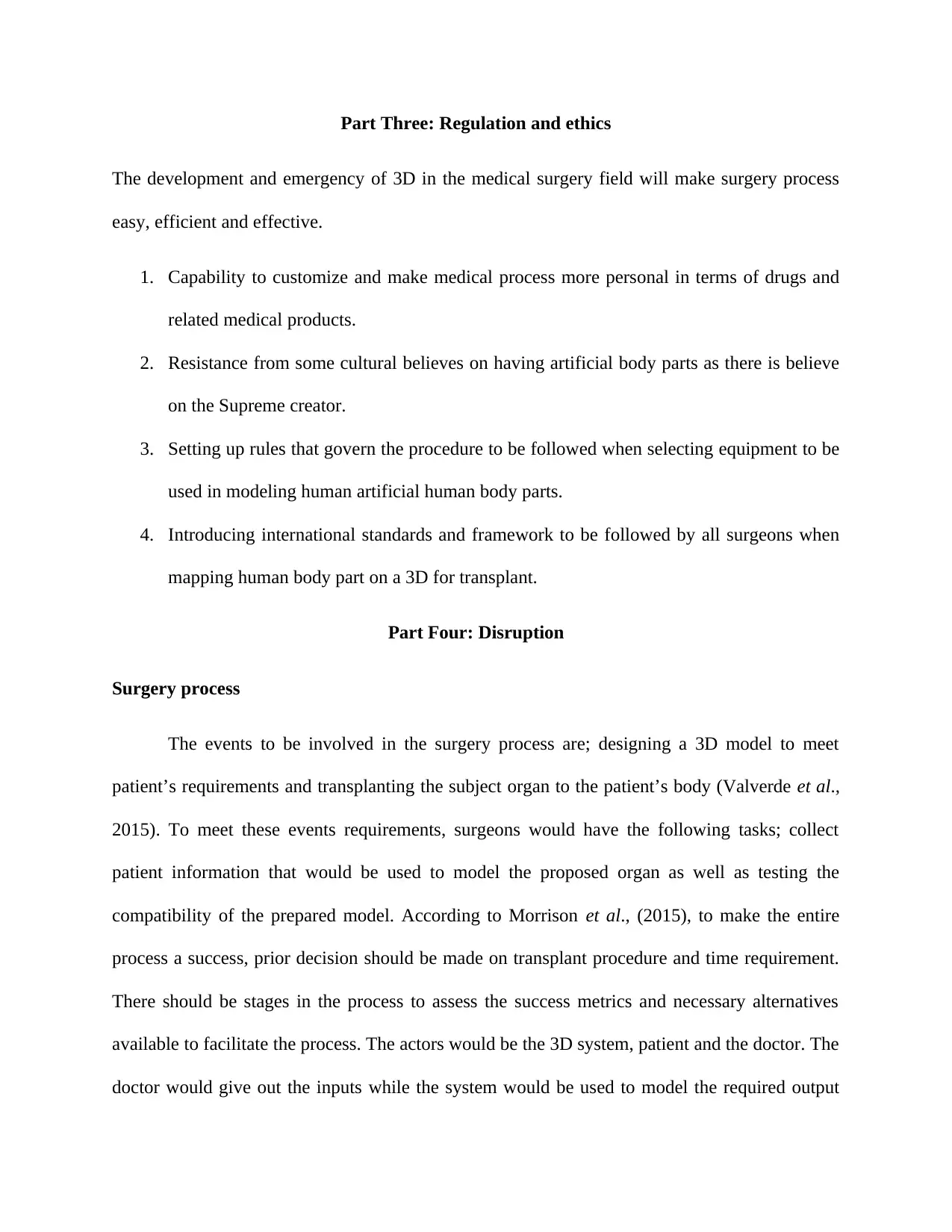
Part Three: Regulation and ethics
The development and emergency of 3D in the medical surgery field will make surgery process
easy, efficient and effective.
1. Capability to customize and make medical process more personal in terms of drugs and
related medical products.
2. Resistance from some cultural believes on having artificial body parts as there is believe
on the Supreme creator.
3. Setting up rules that govern the procedure to be followed when selecting equipment to be
used in modeling human artificial human body parts.
4. Introducing international standards and framework to be followed by all surgeons when
mapping human body part on a 3D for transplant.
Part Four: Disruption
Surgery process
The events to be involved in the surgery process are; designing a 3D model to meet
patient’s requirements and transplanting the subject organ to the patient’s body (Valverde et al.,
2015). To meet these events requirements, surgeons would have the following tasks; collect
patient information that would be used to model the proposed organ as well as testing the
compatibility of the prepared model. According to Morrison et al., (2015), to make the entire
process a success, prior decision should be made on transplant procedure and time requirement.
There should be stages in the process to assess the success metrics and necessary alternatives
available to facilitate the process. The actors would be the 3D system, patient and the doctor. The
doctor would give out the inputs while the system would be used to model the required output
The development and emergency of 3D in the medical surgery field will make surgery process
easy, efficient and effective.
1. Capability to customize and make medical process more personal in terms of drugs and
related medical products.
2. Resistance from some cultural believes on having artificial body parts as there is believe
on the Supreme creator.
3. Setting up rules that govern the procedure to be followed when selecting equipment to be
used in modeling human artificial human body parts.
4. Introducing international standards and framework to be followed by all surgeons when
mapping human body part on a 3D for transplant.
Part Four: Disruption
Surgery process
The events to be involved in the surgery process are; designing a 3D model to meet
patient’s requirements and transplanting the subject organ to the patient’s body (Valverde et al.,
2015). To meet these events requirements, surgeons would have the following tasks; collect
patient information that would be used to model the proposed organ as well as testing the
compatibility of the prepared model. According to Morrison et al., (2015), to make the entire
process a success, prior decision should be made on transplant procedure and time requirement.
There should be stages in the process to assess the success metrics and necessary alternatives
available to facilitate the process. The actors would be the 3D system, patient and the doctor. The
doctor would give out the inputs while the system would be used to model the required output
⊘ This is a preview!⊘
Do you want full access?
Subscribe today to unlock all pages.

Trusted by 1+ million students worldwide
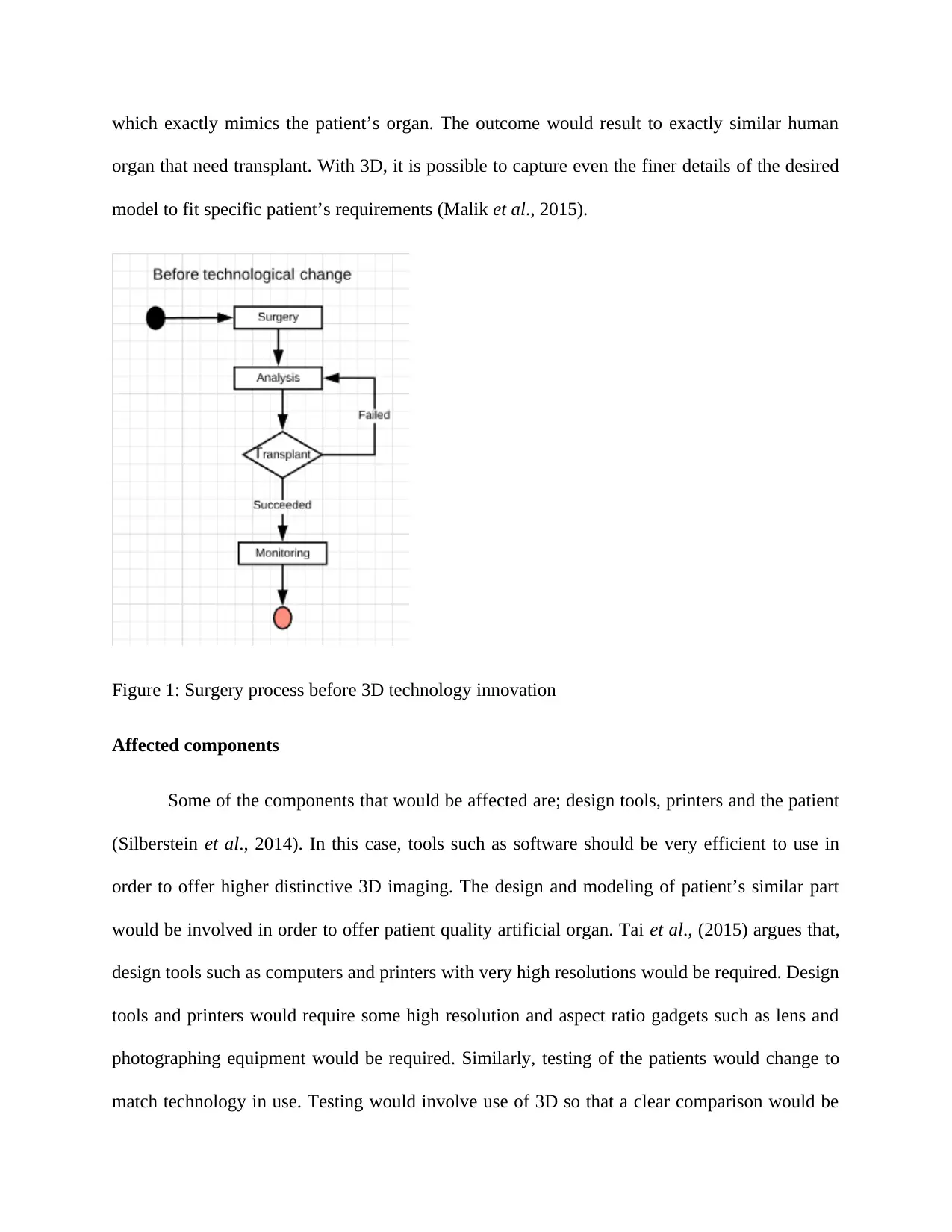
which exactly mimics the patient’s organ. The outcome would result to exactly similar human
organ that need transplant. With 3D, it is possible to capture even the finer details of the desired
model to fit specific patient’s requirements (Malik et al., 2015).
Figure 1: Surgery process before 3D technology innovation
Affected components
Some of the components that would be affected are; design tools, printers and the patient
(Silberstein et al., 2014). In this case, tools such as software should be very efficient to use in
order to offer higher distinctive 3D imaging. The design and modeling of patient’s similar part
would be involved in order to offer patient quality artificial organ. Tai et al., (2015) argues that,
design tools such as computers and printers with very high resolutions would be required. Design
tools and printers would require some high resolution and aspect ratio gadgets such as lens and
photographing equipment would be required. Similarly, testing of the patients would change to
match technology in use. Testing would involve use of 3D so that a clear comparison would be
organ that need transplant. With 3D, it is possible to capture even the finer details of the desired
model to fit specific patient’s requirements (Malik et al., 2015).
Figure 1: Surgery process before 3D technology innovation
Affected components
Some of the components that would be affected are; design tools, printers and the patient
(Silberstein et al., 2014). In this case, tools such as software should be very efficient to use in
order to offer higher distinctive 3D imaging. The design and modeling of patient’s similar part
would be involved in order to offer patient quality artificial organ. Tai et al., (2015) argues that,
design tools such as computers and printers with very high resolutions would be required. Design
tools and printers would require some high resolution and aspect ratio gadgets such as lens and
photographing equipment would be required. Similarly, testing of the patients would change to
match technology in use. Testing would involve use of 3D so that a clear comparison would be
Paraphrase This Document
Need a fresh take? Get an instant paraphrase of this document with our AI Paraphraser
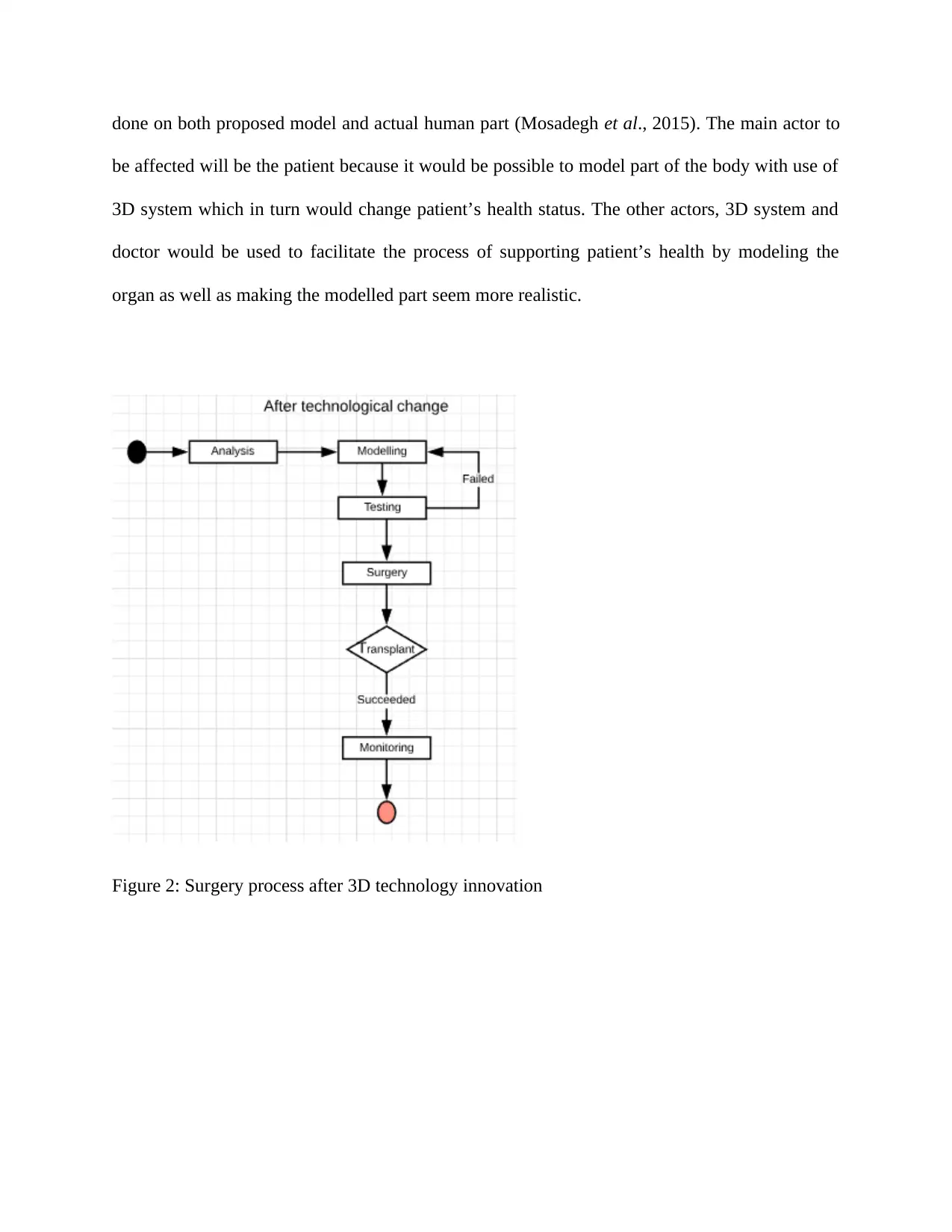
done on both proposed model and actual human part (Mosadegh et al., 2015). The main actor to
be affected will be the patient because it would be possible to model part of the body with use of
3D system which in turn would change patient’s health status. The other actors, 3D system and
doctor would be used to facilitate the process of supporting patient’s health by modeling the
organ as well as making the modelled part seem more realistic.
Figure 2: Surgery process after 3D technology innovation
be affected will be the patient because it would be possible to model part of the body with use of
3D system which in turn would change patient’s health status. The other actors, 3D system and
doctor would be used to facilitate the process of supporting patient’s health by modeling the
organ as well as making the modelled part seem more realistic.
Figure 2: Surgery process after 3D technology innovation
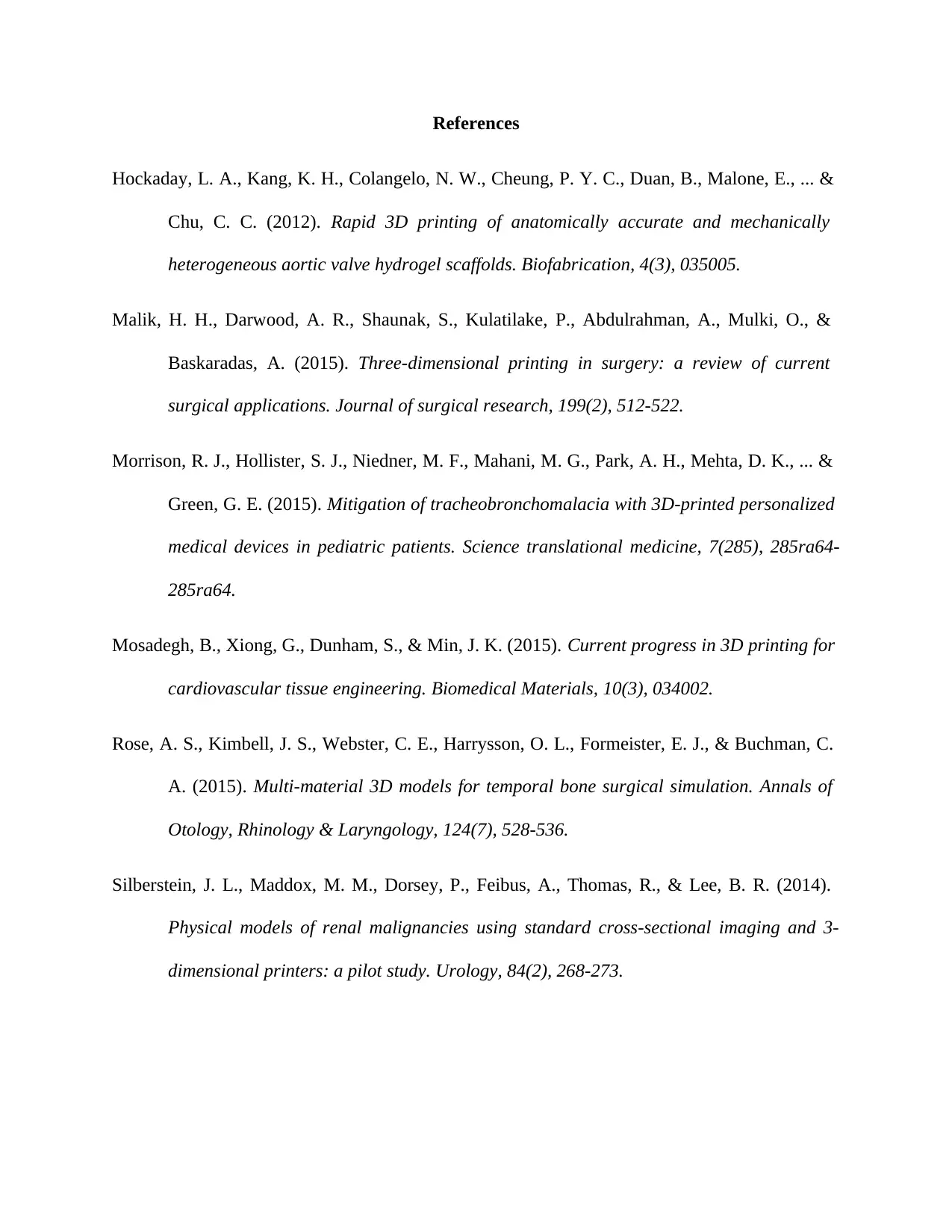
References
Hockaday, L. A., Kang, K. H., Colangelo, N. W., Cheung, P. Y. C., Duan, B., Malone, E., ... &
Chu, C. C. (2012). Rapid 3D printing of anatomically accurate and mechanically
heterogeneous aortic valve hydrogel scaffolds. Biofabrication, 4(3), 035005.
Malik, H. H., Darwood, A. R., Shaunak, S., Kulatilake, P., Abdulrahman, A., Mulki, O., &
Baskaradas, A. (2015). Three-dimensional printing in surgery: a review of current
surgical applications. Journal of surgical research, 199(2), 512-522.
Morrison, R. J., Hollister, S. J., Niedner, M. F., Mahani, M. G., Park, A. H., Mehta, D. K., ... &
Green, G. E. (2015). Mitigation of tracheobronchomalacia with 3D-printed personalized
medical devices in pediatric patients. Science translational medicine, 7(285), 285ra64-
285ra64.
Mosadegh, B., Xiong, G., Dunham, S., & Min, J. K. (2015). Current progress in 3D printing for
cardiovascular tissue engineering. Biomedical Materials, 10(3), 034002.
Rose, A. S., Kimbell, J. S., Webster, C. E., Harrysson, O. L., Formeister, E. J., & Buchman, C.
A. (2015). Multi-material 3D models for temporal bone surgical simulation. Annals of
Otology, Rhinology & Laryngology, 124(7), 528-536.
Silberstein, J. L., Maddox, M. M., Dorsey, P., Feibus, A., Thomas, R., & Lee, B. R. (2014).
Physical models of renal malignancies using standard cross-sectional imaging and 3-
dimensional printers: a pilot study. Urology, 84(2), 268-273.
Hockaday, L. A., Kang, K. H., Colangelo, N. W., Cheung, P. Y. C., Duan, B., Malone, E., ... &
Chu, C. C. (2012). Rapid 3D printing of anatomically accurate and mechanically
heterogeneous aortic valve hydrogel scaffolds. Biofabrication, 4(3), 035005.
Malik, H. H., Darwood, A. R., Shaunak, S., Kulatilake, P., Abdulrahman, A., Mulki, O., &
Baskaradas, A. (2015). Three-dimensional printing in surgery: a review of current
surgical applications. Journal of surgical research, 199(2), 512-522.
Morrison, R. J., Hollister, S. J., Niedner, M. F., Mahani, M. G., Park, A. H., Mehta, D. K., ... &
Green, G. E. (2015). Mitigation of tracheobronchomalacia with 3D-printed personalized
medical devices in pediatric patients. Science translational medicine, 7(285), 285ra64-
285ra64.
Mosadegh, B., Xiong, G., Dunham, S., & Min, J. K. (2015). Current progress in 3D printing for
cardiovascular tissue engineering. Biomedical Materials, 10(3), 034002.
Rose, A. S., Kimbell, J. S., Webster, C. E., Harrysson, O. L., Formeister, E. J., & Buchman, C.
A. (2015). Multi-material 3D models for temporal bone surgical simulation. Annals of
Otology, Rhinology & Laryngology, 124(7), 528-536.
Silberstein, J. L., Maddox, M. M., Dorsey, P., Feibus, A., Thomas, R., & Lee, B. R. (2014).
Physical models of renal malignancies using standard cross-sectional imaging and 3-
dimensional printers: a pilot study. Urology, 84(2), 268-273.
⊘ This is a preview!⊘
Do you want full access?
Subscribe today to unlock all pages.

Trusted by 1+ million students worldwide
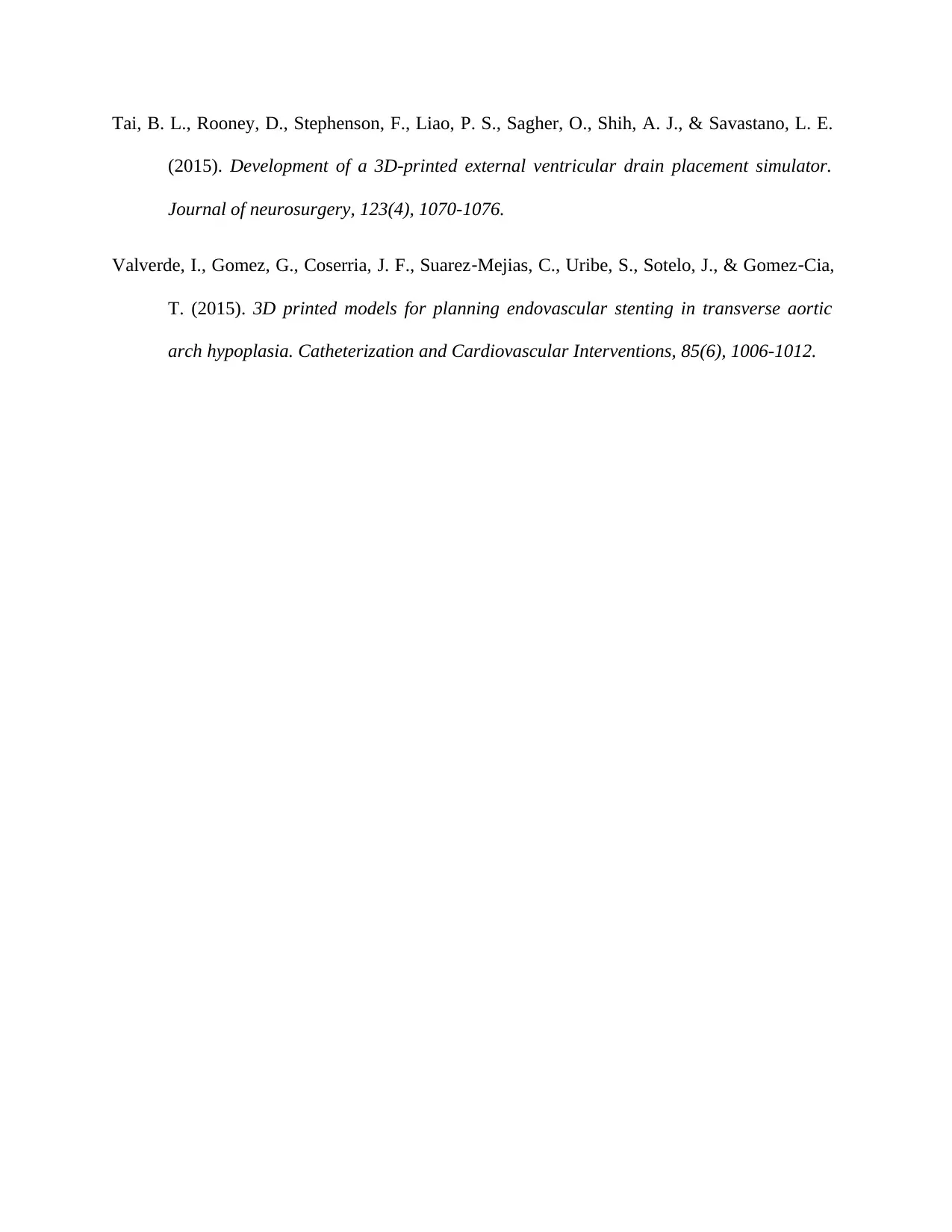
Tai, B. L., Rooney, D., Stephenson, F., Liao, P. S., Sagher, O., Shih, A. J., & Savastano, L. E.
(2015). Development of a 3D-printed external ventricular drain placement simulator.
Journal of neurosurgery, 123(4), 1070-1076.
Valverde, I., Gomez, G., Coserria, J. F., Suarez‐Mejias, C., Uribe, S., Sotelo, J., & Gomez‐Cia,
T. (2015). 3D printed models for planning endovascular stenting in transverse aortic
arch hypoplasia. Catheterization and Cardiovascular Interventions, 85(6), 1006-1012.
(2015). Development of a 3D-printed external ventricular drain placement simulator.
Journal of neurosurgery, 123(4), 1070-1076.
Valverde, I., Gomez, G., Coserria, J. F., Suarez‐Mejias, C., Uribe, S., Sotelo, J., & Gomez‐Cia,
T. (2015). 3D printed models for planning endovascular stenting in transverse aortic
arch hypoplasia. Catheterization and Cardiovascular Interventions, 85(6), 1006-1012.
1 out of 7
Related Documents
Your All-in-One AI-Powered Toolkit for Academic Success.
+13062052269
info@desklib.com
Available 24*7 on WhatsApp / Email
![[object Object]](/_next/static/media/star-bottom.7253800d.svg)
Unlock your academic potential
Copyright © 2020–2025 A2Z Services. All Rights Reserved. Developed and managed by ZUCOL.



